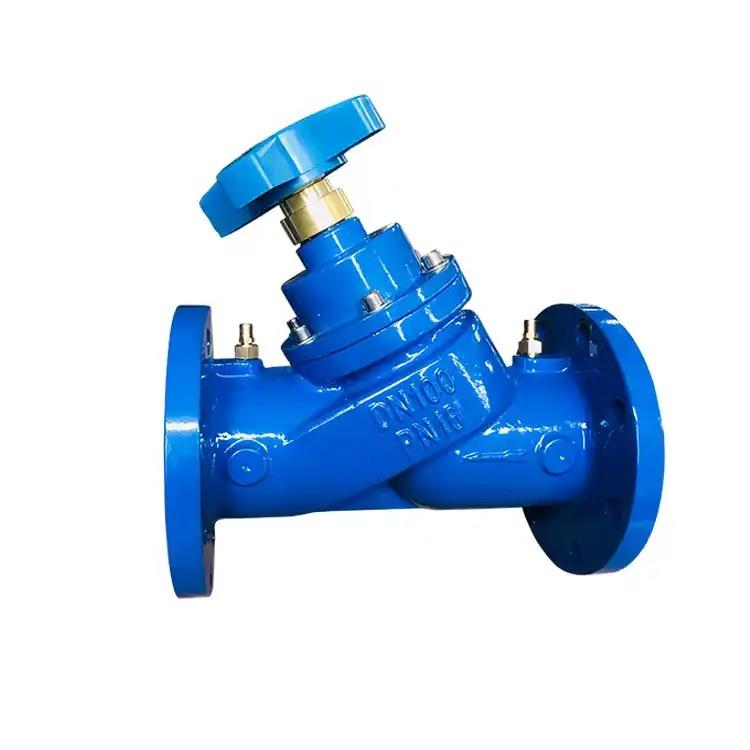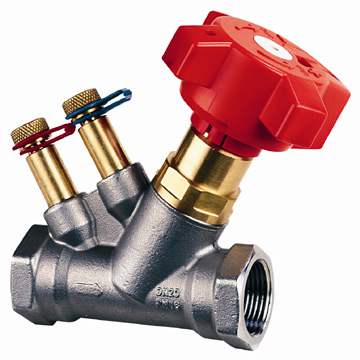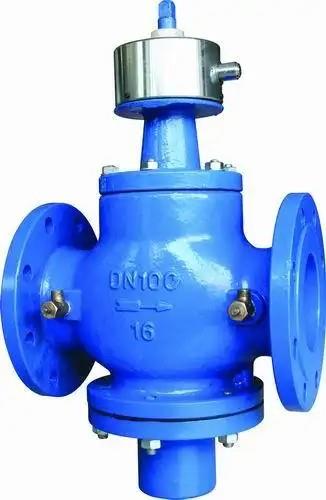How Much Do You Know About The Balancing Valve?
Ⅰ.What is a balancing valve?
A balancing valve is a valve with special functions. In some industries, due to a large pressure difference or flow difference of the medium (various flowable media, such as gases, liquids, etc.) in different parts of the pipeline or container, in order to reduce or balance this difference, a valve is installed between the corresponding pipelines or containers to regulate the relative balance of the pressure on both sides, or to achieve the balance of the flow rate through the method of shunting.
A balance valve plays the role of dynamic and static balance adjustment under hydraulic working conditions.

Ⅱ.Types of balancing valves.
Balance valves can be divided into static balancing valves, dynamic differential pressure balancing valves, dynamic flow balancing valves, dynamic balancing electric control valves, dynamic balancing electric two-way valves, and so on.
1. Static balancing valve(SBV).
Static balancing valves are also known as manual balancing valves or digital locked balancing valves. The adjustment principle of static balancing valves is to manually adjust and change the opening degree of the valve, thereby changing the flow resistance of the valve accordingly to regulate the flow rate.
In fact, a manual balancing valve is a resistance element whose local resistance can be manually adjusted. It can only increase the resistance of the pipeline or system, but cannot reduce it.
①Structure of the static balancing valve.
The structure of this balancing valve includes a valve body with a Venturi flow cross-section, a valve plug, a valve stem, a control knob with digital scales, and pressure measuring holes for measuring the pressure difference between the front and rear of the valve. Red hole represents the inlet, and blue hole represents the outlet.


② Working principle of static balancing valves.
Static balancing valves are generally installed in the return water pipeline and adopt a multi-level adjustment form, that is, static balancing valves are installed in the main pipe, branch main pipe, and branch pipe. When the control knob is rotated to reduce the opening degree of the valve, the flow rate through the balancing valve decreases; when the opening degree is increased, the flow rate through the balancing valve increases. Through the adjustment of the balancing valve, the water flow rate of each branch can reach the designed flow rate.
After the adjustment is completed, the opening degree of each balancing valve is fixed. If the total water flow rate of the system remains unchanged, the system will always be in a balanced state. This is the working principle of static balancing valves.
However, if the water flow rate of the system changes with the number of opened terminals or load changes, dynamic balancing valves are required.
2. Dynamic differential pressure balancing valve.
What is a dynamic differential pressure balancing valve? What is the function of a dynamic differential pressure balancing valve?
For example, nowadays most heating and air-conditioning systems are variable flow systems, which means that the water flow and pressure of the system will change with the load. For example, when some terminals in the system are closed or adjusted, it will affect the flow and pressure of other terminals, causing the pressure and flow of the loop to change even if the regulating valve of other terminal equipment does not act. This is dynamic hydraulic imbalance. The actual operating flow of the equipment deviates from the designed flow, resulting in flow imbalance. This not only causes frequent actions of the room regulating valve, resulting in room temperature fluctuations, but also narrows the adjustment range of the corresponding regulating valve and reduces the valve authority. The regulating characteristic curve changes from linear to quick-opening, which reduces the function of the regulating control valve, and even causes problems such as noise, cavitation, and difficulty in closing. In order to solve a series of impacts caused by dynamic hydraulic imbalance, dynamic differential pressure balancing valves are installed at both ends of terminal equipment in variable flow systems or at positions such as branch pipes and risers of branch loops.
①Structure of dynamic differential pressure balancing valves.
The structure of a dynamic differential pressure balancing valve is mainly composed of an upper driving diaphragm and a lower valve body. The valve is installed on the return water pipeline.
② Working principle of dynamic differential pressure balancing valves.
The pressure on the return water pipeline is introduced into the lower part of the diaphragm chamber through the valve body, while the pressure on the water supply pipeline is introduced into the upper part of the diaphragm chamber through the pressure guiding pipe. The force formed by the pressure difference between the two acting on both sides of the diaphragm and the force generated by the spring deformation in the diaphragm chamber structure reach a state of mutual balance. When the pressure difference changes, the diaphragm in the diaphragm chamber will drive the valve core to move, thereby maintaining the relatively constant pressure difference controlled by the dynamic differential pressure balancing valve.
By keeping the pressure difference on both sides of the load constant, not affected by external system pressure fluctuations, it reduces the mutual interference between parallel loops, thereby improving the stability and accuracy of the system and the control valve, reducing the noise of the control valve, and facilitating dynamic hydraulic balance adjustment. It solves the problem of dynamic hydraulic imbalance in heating, ventilation, air-conditioning, heating and other systems, ensures that the water pump is always at the efficient working point, saves the energy consumption of the water pump, improves the working efficiency of the chilled water system, and reduces the overall energy consumption.
3. Dynamic flow balancing valve.
What is a dynamic flow balancing valve? What is the function of a dynamic flow balancing valve?
A dynamic flow balancing valve is also called a self-operated flow control valve, automatic flow balancing valve, or constant flow valve. As can be judged from its name, its main function is to control the flow rate. When the pressure of the system changes, the dynamic flow balancing valve can automatically adjust the opening of the valve core through the change of its own pressure difference, adapt to the pressure changes before and after the valve, and control and stabilize the flow rate through the valve.
①Structure of the dynamic flow balancing valve.
The dynamic flow balancing valve is mainly composed of a valve body, a manual regulating valve group, and an automatic regulating valve group.
- The manual regulating valve group consists of an O-ring, a manual valve core, an adjusting screw, a flow scale, a locking ring, and a locking cover. Each opening of the manual regulating valve group corresponds to a set flow rate, and the maximum flow rate through the valve can be set by rotating the adjusting screw.
- The automatic balancing valve group is composed of a guide sleeve, an automatic valve core, a spring bracket, a spring, a diaphragm pad, a diaphragm, and a pressure plate.
There is a fluid direction indicator on the valve body, and it must be installed in accordance with the direction indicated by the arrow during installation. The maximum flow rate through the valve can be set through the manual regulating valve group.

② Working principle of dynamic flow balancing valve.
When the pressure on both sides of the diaphragm is unbalanced, the diaphragm will deform with the pressure change, thereby driving the automatic valve core to move, which changes the flow area of the fluid and achieves the purpose of maintaining a constant flow rate.
The dynamic flow balancing valve can limit the maximum flow rate of the equipment and automatically keep the flow rate constant within a certain pressure range. Therefore, it is generally installed at the inlet of the thermal pipeline network, or on the return water pipeline of air-conditioning terminal equipment and other loops that need to maintain a constant flow rate.
Ⅲ. The correct adjustment method of the balance valve.
- Determine the adjustment target.
Before adjusting the balancing valve, it is necessary to clarify the adjustment target. Generally speaking, the adjustment targets include parameters such as temperature, pressure, and flow rate. Users need to determine the specific adjustment target according to their own needs and actual situations. - Check the valve opening.
Before adjusting the balancing valve, it is necessary to check the current valve opening. If the valve opening is too large or too small, it will affect the adjustment effect. Users can obtain the current valve opening information by observing the flowmeter or relevant instruments. - Adjust the valve opening
According to the adjustment target, users need to adjust the valve opening. When adjusting the valve opening, it is necessary to follow the principle of gradual adjustment, and the adjustment range each time should not be too large. At the same time, it is necessary to pay close attention to the operation status of the system to ensure the normal operation of the system. - Monitor the adjustment effect
During the process of adjusting the balancing valve, it is necessary to monitor the adjustment effect. Users can monitor the operation status of the system by observing instruments such as the flowmeter, thermometer, and pressure gauge. If the adjustment effect is not ideal, it is necessary to readjust the valve opening until the ideal adjustment effect is achieved. - Regular maintenance
The balancing valve needs regular maintenance during use. Users need to regularly check whether there are problems such as leakage and blockage of the valve, and regularly clean the impurities inside the valve to ensure the normal operation and service life of the valve. At the same time, it is also necessary to regularly check other components of the system, such as pipelines and water pumps, to ensure the normal operation of the entire system.
In short, the correct adjustment method of the balance valve is of great significance for the normal operation of the system and energy conservation and emission reduction. Users need to understand the basic principle and adjustment target of the balance valve and make adjustments according to the principle of gradual adjustment. At the same time, regular maintenance is also required to ensure the normal operation and service life of the valve. Through correct adjustment and maintenance, the function of the balance valve can be fully utilized, the operation efficiency of the system can be improved, and a better user experience and economic benefits can be brought to users.
